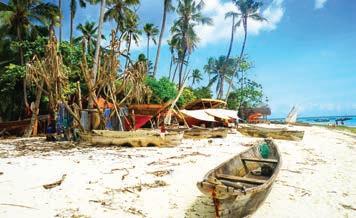
4 minute read
Swahili Coast: The Treasure of Tanzania
Swahili Coast
The Treasure of Africa
Advertisement
Swahili means ‘coastal’ in Arabic, and the Swahili coast refers to Tanzania’s coastline and islands, a beautiful and historic region rich in history, natural beauty, art and culture. Ancient Greek manuscripts show that the east coast of Africa was visited by sailing vessels in classical times. They referred to the coast as Azania, hence the name Tanzania (Tan – Tanganyika; Zan –Zanzibar; and Azania).”
In the ninth or tenth centuries came Shirazi Persians from modern-day language, economy and artistic traditions.
Today, reminders of the
Iran, sailing their ancient dhows across the Indian Ocean. Chinese, Japanese, Russian and Indonesian merchants and pirates, traders and adventurers, all arrived over the centuries during which the Swahili coast was the centre of a thriving commercial civilisation, with its own post can be found up and down the length of Tanzania. The brassbound chests and heavy wooden doors of the Swahili Empire are found on a far island, imported originally by the Arabic slave traders who led caravans into the interior in search of fortune. On the coast itself, crumbling mosques nestle among palm trees by white beaches and Persian baths lie ruined in the remains of ancient villas.
Bagamoyo was once the centre of slave and ivory trading. It was the last point reached by the caravans of slaves who arrived here for transportation to faraway

places. Today this attractive coastal town still bears while waiting for transportation still stands, as does the tree under which they were bought and sold.
KILWA
Kilwa Kisiwani Island was once the trading centre of the Swahili Empire. The ruins of the settlement still remain and are considered to be one of the most important Swahili historical sites in East African. The
famous traveller and chronicler lbn Battuta visited Kilwa in the 14th century, describing his admiration for the architecture and graceful situation of the capital city. Later the island became a trading post for slaves travelling north from Mauritius and Mozambique. The end of the town supremacy as a trading port came when it was ransacked, ostensibly by “cannibals’’ in 1588. from ancient Yemen who dominated the coast around archipelago, off beaten track and known to only the most discerning travellers. The island is surrounded by a barrier reef so rich in marine life it has been designated a marine park by the World Wide Fund for Nature. A tiny population of pygmy hippo lives in the remains of an old lagoon, cut off from the mainland centuries. the 13th century. There is also Ngezi Forest, a beautiful untouched rainforest and home to the Pemba Flying Fox, a giant bat!
PEMBA
Pemba Island, rumored to have once been inhabited by a race of mythical giants, is an untouched beauty that offers an undiluted experience of island life in the Indian Ocean. The tiny number of visitors to Pemba every year means that the island has little in the way of tourist infrastructure – which for alternative travellers is the main attraction. Small guesthouses are dotted around the island, and there are a couple of upmarket diving hotels and resorts. There are many historical sites and ruins to explore on Pemba including a number of old mosques and tombs and the old town fort of Chake Chake. The Pujini ruins south-east of Chake Chake are the remnants of
TANGA AND PANGANI
Ruins close to the active port of Tanga attest to its importance as a trading post in the Swahili trading empire. The ruins, once a large mosque, include more than 40 tombs, Tanga has pleasant beaches and is a convenient point from which to visit the spectacular Usambara Mountains. Just south of Tanga is Pangani, once the home of Arab slave traders, set on a lovely estuary of the Panani River.




ZANZIBAR (UNGUJA ISLAND)
For a small island in the southern waters of the Indian Ocean, Zanzibar has a long and unexpected history. For centuries the island has been a centre of slave and ivory trade, if not all trading, from central Africa to the rest of the world and was the world’s main producer of the highly valued clove spice. It is also the centre of Swahili language and culture. Zanzibar is the undisputed capital of the Swahili coast. encounter this vast trading network and culture around Zanzibar were the Portuguese, who arrived in the late 15th Century. The Portuguese were ousted with the help of Oman, in the mid- 16th Century, whose vast trade connections had been severed by the entrance of the Portuguese.
Zanzibar became the seat of the Omani empire, when Sultan Seyyid Said moved his capital from Muscat to Zanzibar in 1840, due largely to its economic importance in the empire and unrest at home. This was to last only 50 years until the British, keen on expanding their colonial reach, declared Zanzibar a British Protectorate. This, in turn, was to last until 1963, when the British handed power back to the Sultan in a constitutional monarchy which was itself overthrown in early 1964 in a violent revolution which established the Revolutionary Government of Zanzibar, which rules the country to this day.
Picture Courtesy of Moiz Husein


